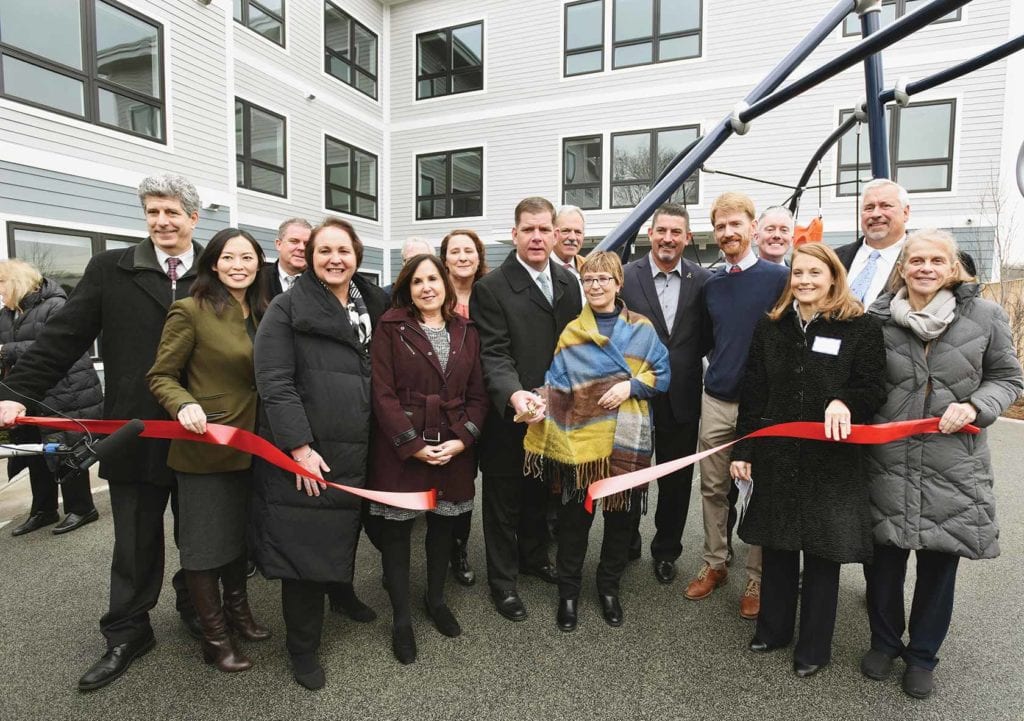
It took the Southwest Boston Community Development Corporation more than 20 years to see its 27-unit all-affordable housing building through to completion, so when Mayor Martin Walsh and leadership from the organization cut the ribbon on the development last Thursday, it was a big deal.
The Residences at Fairmount Station is a $12 million four-story building nestled between the Fairmount Station commuter rail stop and Fairmount Avenue, with 24 of its units affordable to families earning 60 percent of the area median income or below. The building contains a mixture of studios, one-, two- and three-bedroom units.
The development faced fierce pushback from Hyde Park residents when it was first proposed during the late 1990s, said SBCDC board member Diana Kelley.
“The community voted it down,” she said.
Then-Mayor Thomas Menino’s administration did not push for the development, which the CDC had originally proposed for another site, but instead steered the project to the Fairmount site, at that time a collection of dilapidated industrial buildings. That move kicked off a nearly-10-year process during which the CDC pieced together the parcel of land from private owners and the MBTA, while at the same time negotiating with neighbors over issues including the size of the building and the amount of parking.
“I don’t know that you can build affordable housing in any neighborhood and not encounter some opposition,” Kelley said. “What’s important is that we were able to get some compromises.”
Among the compromises, plans were altered to include three units available for families earning up to 70 percent of the area median income, up from 60 percent. A playground that abutters felt was too close to the MBTA tracks was moved to the opposite side of the building.
The end result is a building affordable to households earning $21,000 to $58,000, said SBCDC Board President Mimi Turchinetz, addressing elected officials and neighborhood residents gathered for the ribbon cutting Thursday.
“The units are affordable to the majority of residents of Hyde Park,” she noted.
Demand for the units is substantial, with more than 2,700 applications submitted for the 27 available units.
“The need for affordable housing that’s kid-friendly is enormous,” Turchinetz said.
Mayor Martin Walsh said the building fits into the city’s goals to increase the amount of affordable housing available as rents increase in neighborhoods along the Fairmount Line Corridor — the commuter rail line that cuts through Hyde Park, Mattapan, Dorchester and Roxbury, with new stops in many of those neighborhoods.
Walsh administration officials hope the transit line will spur new economic development in the southwestern part of the city.
“We want inclusive development,” Walsh said. “We want transit-oriented development. We want development without displacement.”
Walsh said the new building would also support businesses in the Cleary Square commercial district in Hyde Park.
“You can’t have a thriving business district if you don’t have people there,” he said.
The affordable development was made possible in part by a City of Boston contribution of more than $1.7 million. This contribution enabled the development team to take advantage of more than $2.5 million from the state’s Department of Housing and Community Development. The state also provided an allocation of almost $1.5 million in federal Low-Income Housing Tax Credits that helped raise over $4.7 million in equity from National Equity Fund, the equity investor in the project. Webster Bank provided a construction loan, with MassHousing providing long-term permanent financing. The Community Economic Development Assistance Corporation and the Equitable Transit-Oriented Development Accelerator Fund at LISC Boston provided critical pre-development and acquisition funding to secure the site.







